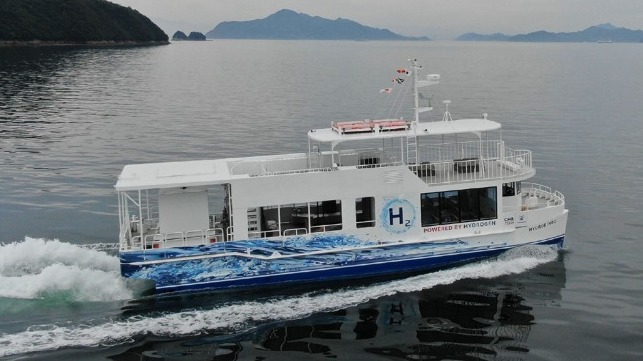First Dual-Fuel Hydrogen Ferry Completed in Japan

The world’s first hydrogen-fueled passenger ferry using a dual-fuel combustion engine completed construction in Japan and is now preparing for deployment as the next step in the development of hydrogen technology. The vessel expands on earlier efforts by Belgium’s CMB.Tech and is part of a program that will develop different engine sizes as the company works towards the next generation of engines, which will operate solely on hydrogen.
Japan’s Tsuneishi Craft & Facilities Co. built the new ferry in coordination with CMB.Tech. The vessel, the Hydro Bingo, is a 19-ton two-deck passenger ferry able to transport 80 passengers with a crew of two. The vessel is a catamaran built of aluminum alloy and equipped with a hydrogen co-firing engine that combines the hydrogen with diesel fuel.
One of the other innovations used on the vessel is a movable hydrogen storage tank at the rear of the ship. It is designed to supply hydrogen to the engine through a separate line from light oil for co-firing. The advantage that the tank design offers is that there is no need for hydrogen filling equipment and transportation to supply hydrogen. Refueling is done with a trailer via roll-on/roll-off hydrogen storage.
This ship is equipped with two hydrogen and light oil co-firing engines. As it still uses diesel, the vessel is not zero emissions. “The carbon reduction is based on the hydrogen to diesel ratio, which can range from 50 to 80 percent, depending on the application,” explains CMB. “This solution is excellent while we build a consumption demand that allows the refueling and bunkering infrastructure to develop.”
The vessel is 63 feet long and is expected to have a cruising speed between 18 and 22 knots. The vessel will be operating in Japan’s Inland Sea and the hydrogen for the operations will be supplied by Japanese chemical company Tokuyama.
The Hydro Bingo follows an earlier passenger shuttle and used information learned with the first marine vessel to enhance the storage capabilities for the hydrogen. CMB in partnership with Tsuneishi will also be building a hydrogen-fueled crew transfer vessel and a hydrogen tug as part of the development program.
“We are already working on the next generation of engines, which will operate solely on hydrogen, but these can only be deployed once the infrastructure is mature,” says Paul Turner, Managing Director of CMB.Tech UK. “A step-by-step approach is required. Our initial work has shown that pure hydrogen engines can be run at almost any size, without any engine-out emissions.”
Tsuneishi has previously developed and constructed environment-friendly vessels such as electric propulsion vessels and aims to establish a zero-emission vessel that utilizes hydrogen fuel by building on the technology it has cultivated.
